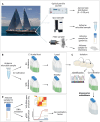Impact of airborne algicidal bacteria on marine phytoplankton blooms
- PMID: 38442732
- PMCID: PMC10944695
- DOI: 10.1093/ismejo/wrae016
Impact of airborne algicidal bacteria on marine phytoplankton blooms
Abstract
Ocean microbes are involved in global processes such as nutrient and carbon cycling. Recent studies indicated diverse modes of algal-bacterial interactions, including mutualism and pathogenicity, which have a substantial impact on ecology and oceanic carbon sequestration, and hence, on climate. However, the airborne dispersal and pathogenicity of bacteria in the marine ecosystem remained elusive. Here, we isolated an airborne algicidal bacterium, Roseovarius nubinhibens, emitted to the atmosphere as primary marine aerosol (referred also as sea spray aerosols) and collected above a coccolithophore bloom in the North Atlantic Ocean. The aerosolized bacteria retained infective properties and induced lysis of Gephyrocapsa huxleyi cultures.This suggests that the transport of marine bacteria through the atmosphere can effectively spread infection agents over vast oceanic regions, highlighting its significance in regulating the cell fate in algal blooms.
Keywords: Gephyrocapsa huxelyi; aerial infection; airborne pathogen; marine bioaerosols; oceanic blooms; ocean–atmosphere interactions.
© The Author(s) 2024. Published by Oxford University Press on behalf of the International Society for Microbial Ecology.
Conflict of interest statement
Authors declare no conflict of interests.
Figures





 denotes calcified strains.
denotes calcified strains.
References
-
- Tyrrell T, Merico A. Emiliania huxleyi: bloom observations and the conditions that induce them. In: Thierstein H.R., Young J.R. (eds.), Coccolithophores: From Molecular Processes to Global Impact. Berlin, Heidelberg: Springer, 2004, 75–97.
MeSH terms
Grants and funding
LinkOut - more resources
Full Text Sources

